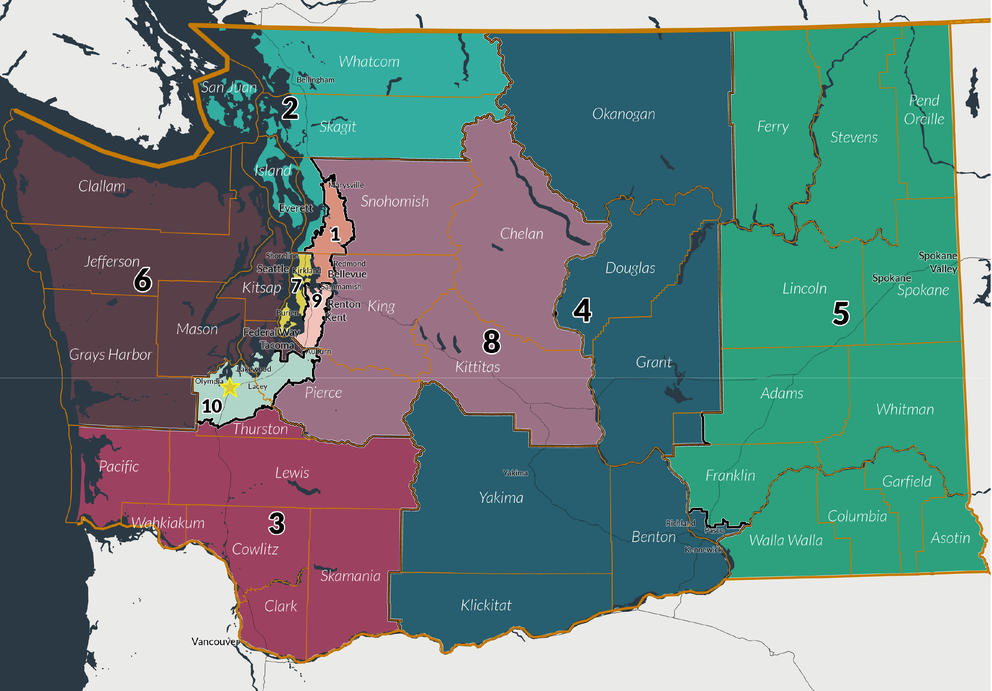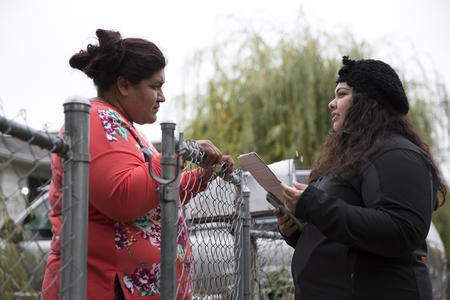The commission meets every 10 years to redraw the state’s congressional and legislative district boundaries. While the commission’s primary task is to rebalance districts so they’re equal in population, the process also determines which party has an advantage and whether communities of color are divided between districts, diluting their voting power.
But last year, Washington’s bipartisan commission didn’t approve a new set of political maps by its constitutional deadline of Nov. 15. Instead, the commissioners met in private for most of their five-hour meeting that day, emerging just minutes before their midnight deadline to approve a plan that wasn’t written down and wasn’t discussed in public.
Multiple lawsuits have been filed alleging the commission violated the state’s Open Public Meetings Act, as well as the federal Voting Rights Act.
Now, a debate is underway at the state Capitol about how to best reform the Redistricting Commission to prevent a repeat of last year’s confusing finish.
A proposal from state Sen. Jamie Pedersen, D-Seattle, would require that the state’s redistricting commissioners approve a concrete redistricting plan that includes finalized maps, not just a verbal agreement, by their Nov. 15 deadline. That measure, Senate Bill 5560, would also require fleshed-out redistricting plans to be made public at least three days before a final vote.
The bill unanimously cleared the state Senate on Feb. 2 and is being considered by the state House.
Others argue that Washington's redistricting system — long regarded as one of the best in the nation because it is bipartisan and doesn't let the party in power steamroll the process — needs to be restructured more dramatically. That most likely would require amending the state constitution.
“It does not go far enough,” said Darrell Powell of the regional NAACP at a Jan. 19 hearing on Pedersen’s bill. Powell said he would like to see the commission include more community members as opposed to partisan appointees, and he wants the commission to focus more on “centering equity” when making decisions about the state’s political future.
Right now, each of the Legislature’s four political caucuses appoints a member to the Redistricting Commission, so that two Democrats and two Republicans make the decisions on drawing district lines. At least three of the commission’s voting members have to agree on new legislative and congressional maps for those maps to move forward.
That’s a far cry from how redistricting works in many states, where the party that controls the Legislature is essentially in charge of redrawing political maps. But Washington’s system still leads to partisan-driven decision-making, Powell and other critics said.
This week, the Redistricting Commission’s former communications director, Jamie Nixon, joined the chorus of people calling for a serious overhaul of the commission. Nixon wrote on Twitter that the commission needs to be “blown up” and replaced with something that isn’t so connected to the major political parties.
“I think the public would be (if not shocked) let down that the Commission itself is simply window dressing for the leadership of the four caucuses to negotiate between each other,” Nixon wrote, calling the commission a “good-government illusion.”
Nixon, a former House Democratic communications staffer, filed a $1.5 million tort claim last month alleging he was wrongfully terminated from the Redistricting Commission. Nixon alleges his firing stemmed partly from concerns he raised internally about how the commission was operating last year.
Lisa McLean, the commission’s executive director, declined to comment on Nixon’s criticisms of the commission, citing Nixon’s ongoing legal claim.
Members of the Redistricting Commission have said publicly that while negotiating new political boundaries in 2021, their final disagreements centered on certain legislative swing districts and how well they would perform for Democrats versus Republicans.
Text messages among the commissioners, which Crosscut obtained through a public records request, indicate that in those final days, commissioners were discussing how to keep two Republican lawmakers, Sen. Phil Fortunato and Rep. Jim Walsh, in their current districts, while also debating by how many percentage points certain districts should shift to favor one party or another.
The Democratic commissioners, meanwhile, talked about the "need to protect" state Rep. April Berg, D-Mill Creek. And commissioners from both parties communicated with members of the political caucuses that appointed them, including leaders of the caucuses' campaign committees.
This is the Washington State Redistricting Commission's proposed map for the state's 10 congressional districts. The Legislature approved this map with some minor changes on Feb. 8. But this map and the map of the state's newly redrawn legislative districts still could be amended due to ongoing lawsuits.
Andrew Hong, the statewide coordinator with Redistricting Justice For Washington, a coalition of more than 25 community groups, said a Redistricting Commission made up of citizen appointees would reduce the commission’s focus on political issues and place it more squarely on how to ensure fair representation for people across the state, including for communities of color.
With the current commission system, Hong said, “What you see is that negotiations come down to partisan statistics and not communities of interest.”
Changing the makeup of the state Redistricting Commission wouldn’t be easy. It would require a constitutional amendment, which requires not only a public vote, but also the approval of two-thirds of Washington lawmakers.
Hong said his coalition is already working to build support for such an amendment, as is the League of Women Voters of Washington. Both groups have called on lawmakers to hold a work session to explore changes to redistricting beyond what is being considered in the Legislature this year. Washington’s current system has been in place only since 1983, when voters approved another constitutional amendment creating the bipartisan commission. Before that, redistricting in Washington was similar to the system used in other states.
Pedersen, the sponsor of SB 5560, wrote in a text message that he doesn’t think there are enough votes in the Legislature right now to add citizens to the commission or change its structure. That’s why he pursued the more modest reforms contained in SB 5560, which don’t require a constitutional amendment and have “broad bipartisan agreement,” he said.
The two Republican members of the 2021 Redistricting Commission, Paul Graves and Joe Fain, said they support the changes contained in Pedersen’s bill.
“Because redistricting is a once-a-decade process, it is worth reflecting on ways to improve shortly after the commission completes its work,” Graves wrote in an email.
The two Democratic members of the commission, April Sims and Brady Piñero Walkinshaw, didn’t respond to messages requesting comment.
On Tuesday, the Legislature approved the new legislative and congressional district maps forwarded by the Redistricting Commission, making several changes requested by county auditors. Legislative leaders described the changes as minor and technical in nature. One such change involved correcting an issue where one property was split between two political districts, said House Majority Leader Pat Sullivan, D-Covington.
Under state law, the Legislature is barred from making major changes to the maps approved by the commission.
Still, there’s a possibility the approved maps are less than final. In response to lawsuits alleging the commission violated the state's Open Public Meetings Act, a judge theoretically could overturn the commission’s work, declaring it null and void.
Another lawsuit alleging the suppression of Latino voters in the Yakima Valley could lead to redrawing of legislative districts in that area.
A resolution to those lawsuits isn’t expected for many months.







